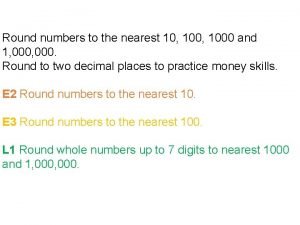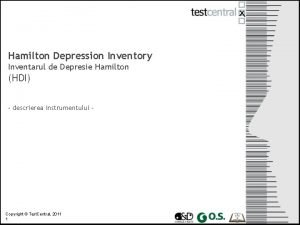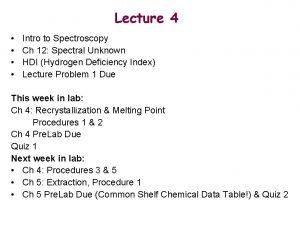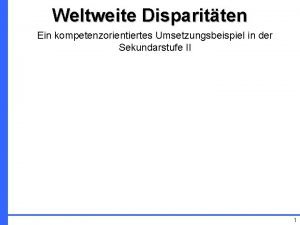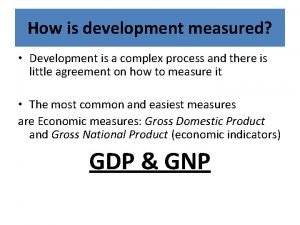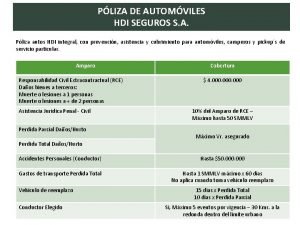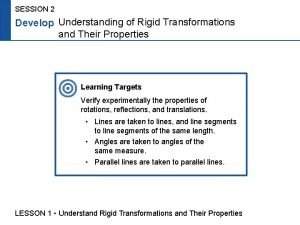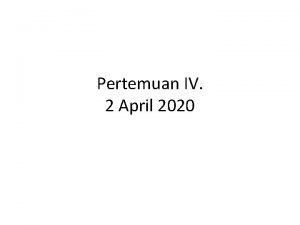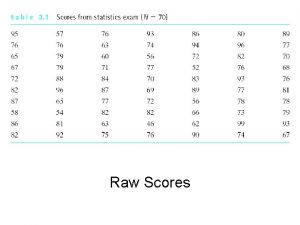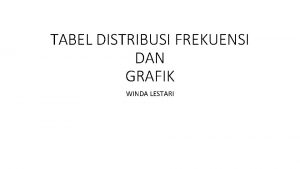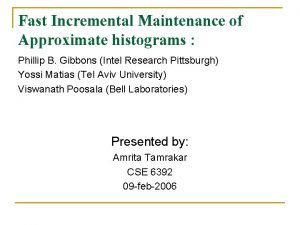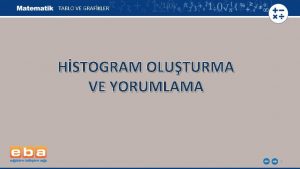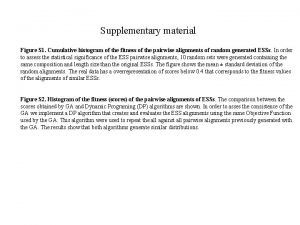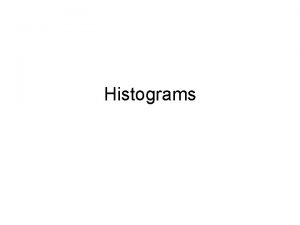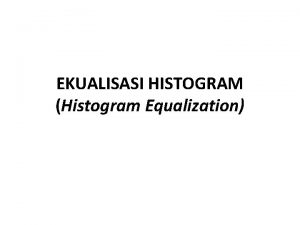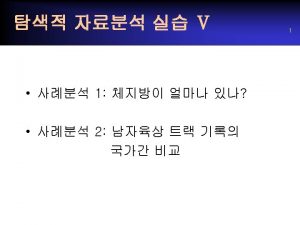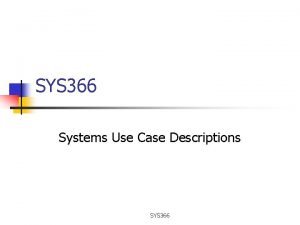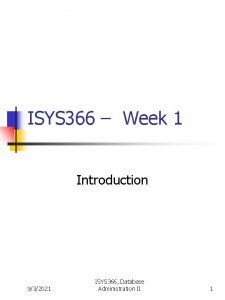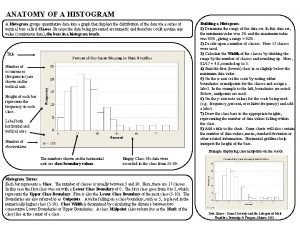PS 366 5 Figure 1 Histogram of HDI
















































- Slides: 48

PS 366 5

Figure 1: Histogram of HDI

Discuss Figure 1 • Figure 1 displays the distribution of HDI for x countries. The figure illustrates that most countries score rather high, with over 20 countries scoring above. 8… • The mean is x, and the median is x. The median may better represent the typical country because… • The distribution has a negative skew

Exercise 1 • Discuss and describe distribution of three variables – Fig. 1 HDI – Fig. 2 GDP – Fig. 3 A third measure • Define the concept ‘development. ’ Discuss validity of each measure.

Topics • • Presidential nominations Campus climate, inclusiveness Media consumption & attitudes Capitalism / socialism

Variation: Chapter 4 • How are observations distributed around the central point? • Is there one, more central point? – unimodal – bimodal

Variation • Which is unimodal, which is bimodal: – Mass public ideology • V con, moderate, lib, v. lib – Members of Congress ideology – What does the mean?

Distribution • How spread out are the observations? • Single peak – not much variation • Flat? – lots of variation; what does mean?

Variation • Variance & Standard deviation • Information about variation around the mean

Variation 125 92 72 126 120 99 130 100 mean = 108 Variance = sum of squared distances of each obsv from mean, over # of observations

Variance • Mean 125 92 72 126 120 99 130 100 mean = 108 (x - mean) 125 -108 92 -108 72 -108 126 -108 120 -108 99 -108 130 -108 100 -108

Variance • Mean 125 92 72 126 120 99 130 100 mean = 108 (x - mean)2 17 -16 -36 18 12 -9 22 -8 289 256 1296 324 144 81 484 64 sum sqs=2938 • THEN, 2938/8

Variance & Std. deviation • Variance does not tell us much • Standard deviation = square root of variance • mean = 108 • variance = 2938 / (n-1) • variance = 2938 / 7 • sd = sqrt 419. 7 • = 20. 4 • = 419. 7

Variation 125 92 72 126 120 99 130 100 mean = 108 • Variance = 419 • SD = 20. 4

Variation • Range ( lo – hi) • Variance (sum of distances from mean, squared) / n • Standard Deviation – Bigger # for each = more variation

Variation Standard Deviation • expresses variation around the mean in ‘standardized’ units – gives picture of distribution • Bigger # = more variation • Allow us to compare apples to oranges

Standard Deviation: Examples • Total convictions for corruption in state – mean = 178, s. d. = 199. 7 • Per capita convictions (per 10, 000 officials) – mean =. 357, s. d. =. 197

Standard Deviation Low s. d relative to mean High s. d. relative to mean; and/or lots of skew

Standard deviation (if normal distribution) • Expressed in same units as mean • Reflects how many observations ‘expected’ around and beyond the mean • Most observations -3 sd to +3 sd observations beyond mean • 68% -1 sd to +1 sd

Standard Deviation Mean. 357, s. d. . 197

Standard Deviation Turnout by state: mean =. 62 ; s. d. =. 07

Standard Deviation • Tells even more if distribution ‘normal’ • Mean for convictions. 36, for turnout 60% • What about a state that has 75% turnout, and. 5 corruption convictions per 10, 000? • Where in each distribution?

Std Dev & Normal Curve

Std Dev & Normal Curve

Std Dev & Normal Curve

Std Dev & Normal Curve

Standard Deviation X Mean. 357, s. d. . 197

Standard Deviation X Turnout by state: mean =. 62 ; s. d. =. 07

Standard Deviation & z-scores • State w/ 75% voter turnout, translate into standardize distance from mean z= (score – mean) / s. d. = (. 75 -. 61) /. 07 = =. 14 /. 07 = +2. 00 standard deviations above mean on turnout

Standard Deviation & z-scores • State w/. 5 corruption convictions = z z= (score – mean) / s. d. – = (. 50 -. 35) /. 19 = – = +. 15 /. 19 = + 0. 78 standard deviations above mean on corruption

Standard Deviation & z-scores • Apples: Where is a state if Turnout z= +1. 84? • Oranges: Where is a state if Corruption z = -1. 28? • Z = 0 is mean • Z = -3 or +3 very rare

Chpt. 5: Z scores and Normal Curve • How many states between mean & +1. 84 • How many above 1. 84 • See Appendix in text – below mean = 50% – between mean and z=1. 84 = 46. 7% – beyond mean = 3. 3% [1. 5 states if normal]

Z scores and Normal Curve • How many states between mean & -1. 28 • How many below z= - 1. 28 • See Appendix C in text – above mean = 50% – between mean and z= -1. 28 = 39. 9% – beyond mean = 10. 3% [1. 5 states if normal]

Time speaking, in seconds ranked

Frequency Distribution: Mean = 729

Trumped • Trump • Bush • Mean +2. 17 sd beyond mean +1. 19 sd 0. 0 sd • Huckabee -0. 92 sd • Walker -1. 20 sd below mean

Problem 7, p. 124: Divorce rates per 1000 • • • AK FL ID ME MD NV NJ TX VT WI 4. 3 4. 7 4. 9 4. 5 3. 1 6. 5 3. 0 3. 3 3. 8 2. 9 • Calculate mean, – sum /n • Calculate standard deviation – square root of variance – variance = sum of squared distances from mean / (n 1)

Problem 7, p. 124: Divorce rates • • • AK FL ID ME MD NV NJ TX VT WI 4. 3 4. 7 4. 9 4. 5 3. 1 6. 5 3. 0 3. 3 3. 8 2. 9 • Sum = 41 • N= 10 • mean = 4. 1

Problem 7, p. 124: Divorce rates • • • AK FL ID ME MD NV NJ TX VT WI 4. 3 4. 7 4. 9 4. 5 3. 1 6. 5 3. 0 3. 3 3. 8 2. 9 distance from mean 4. 3 -4. 1 =0. 2 4. 7 -4. 1 =0. 6 4. 9 -4. 1=0. 8 4. 5 -4. 1 =0. 4 3. 1 -4. 1=-1. 0 6. 5 -4. 1=2. 4 3. 0 -4. 1= -1. 1 3. 3 -4. 1= -0. 8 3. 8 -4. 1=-0. 3 2. 9 -4. 1=1. 2 squared. 04. 36. 64. 16 1. 0 5. 76 1. 21 0. 64. 09 1. 44 Sum = 11. 34

Problem 7, p. 124: Divorce rates • Variance = 11. 34 / (n-1) 11. 34 / 9 = 1. 21 • Std. Deviation = square root of variance – SD = 1. 1 – 68% of states +/- 1. 1 units above mean (4. 1) • Why variation in divorce rates across states?

Chapter 5: Normal Curve • Coin flip example http: //www. fourmilab. ch/rpkp/experiments/sta tistics. html

Normal Curve • Any one sample has random variation • More random samples = less variation around central point • More random samples = approach ‘normal’ distribution

Flip a coin 4 times: what probability of 0 heads, 1, 2, 3, or 4 heads?

Flip 2 coins 8 times: what probability of 1 head, 2 heads, 3, 4?

Probability of heads

Start flipping coins • 1 coins, 4 times: – – – 0 heads: 1 heads: 2 heads: 3 heads: 4 heads: • 1 coin, 4 times – – – 0 heads: 1 head: 2 heads: 3 heads: 4 heads:

Start flipping coins • 1 coins, 16 times: – – – 0 heads: 1 head: 2 heads: 3 heads: 4 heads:

Chpt. 5: Z scores and Normal Curve • How many states between mean & +1. 84 • How many above 1. 84 • See Appendix in text – below mean = 50% – between mean and z=1. 84 = 46. 7% – beyond mean = 3. 3% [1. 5 states if normal]
 Opwekking 366
Opwekking 366 Each pair of wires is wrapped in metallic foil
Each pair of wires is wrapped in metallic foil 92 rounded to the nearest ten
92 rounded to the nearest ten 98 366
98 366 Ps 366
Ps 366 Na jednom kraju bakrene cijevi duljine 366 m
Na jednom kraju bakrene cijevi duljine 366 m Pobble 365 dragons
Pobble 365 dragons The term development refers to
The term development refers to Compare india and sri lanka on the basis of hdi
Compare india and sri lanka on the basis of hdi Skema hdi
Skema hdi Romania hdi
Romania hdi Types of spectroscopy
Types of spectroscopy Contoh perhitungan bonus hdi
Contoh perhitungan bonus hdi Hdi equation
Hdi equation Analysespinne geographie
Analysespinne geographie Bengi tetik
Bengi tetik Hdi vermittler
Hdi vermittler Kanada rozloha
Kanada rozloha Pliza
Pliza Hdi nackdelar
Hdi nackdelar Hdi kundenportal
Hdi kundenportal Hdi image
Hdi image Western europe hdi
Western europe hdi Hdi ap human geography
Hdi ap human geography Hdi ochem
Hdi ochem Hdi als arbeitgeber
Hdi als arbeitgeber Four pillars of gross national happiness
Four pillars of gross national happiness Is a trapezoid a plane figure
Is a trapezoid a plane figure An operation that maps an original figure called the
An operation that maps an original figure called the How do 6 figure grid references work
How do 6 figure grid references work Abcye
Abcye Slike kontrasta
Slike kontrasta Grafik frekuensi kumulatif kurang dari
Grafik frekuensi kumulatif kurang dari Hasil dari 476:17+41×12 adalah
Hasil dari 476:17+41×12 adalah Frequency distribution table for ungrouped data
Frequency distribution table for ungrouped data Histogram processing in digital image processing
Histogram processing in digital image processing Tabel frekuensi
Tabel frekuensi In a dark image the components of histogram
In a dark image the components of histogram Histogram germe
Histogram germe Equi depth histogram
Equi depth histogram Histogram grafiği yorumlama
Histogram grafiği yorumlama Cumulative histogram
Cumulative histogram Resource histogram
Resource histogram Trombosit histogram
Trombosit histogram Histogram and frequency polygon
Histogram and frequency polygon Graf histogram
Graf histogram Juran histogram
Juran histogram What is histogram and example?
What is histogram and example? Histogram citra
Histogram citra


